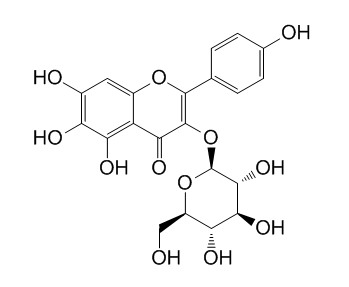6-Hydroxykaempferol 3-O-beta-D-glucoside
6-Hydroxykaempferol 3-O-beta-D-glucoside has anti-thrombotic,and antioxidative activities.
Inquire / Order:
manager@chemfaces.com
Technical Inquiries:
service@chemfaces.com
Tel:
+86-27-84237783
Fax:
+86-27-84254680
Address:
1 Building, No. 83, CheCheng Rd., Wuhan Economic and Technological Development Zone, Wuhan, Hubei 430056, PRC
Providing storage is as stated on the product vial and the vial is kept tightly sealed, the product can be stored for up to
24 months(2-8C).
Wherever possible, you should prepare and use solutions on the same day. However, if you need to make up stock solutions in advance, we recommend that you store the solution as aliquots in tightly sealed vials at -20C. Generally, these will be useable for up to two weeks. Before use, and prior to opening the vial we recommend that you allow your product to equilibrate to room temperature for at least 1 hour.
Need more advice on solubility, usage and handling? Please email to: service@chemfaces.com
The packaging of the product may have turned upside down during transportation, resulting in the natural compounds adhering to the neck or cap of the vial. take the vial out of its packaging and gently shake to let the compounds fall to the bottom of the vial. for liquid products, centrifuge at 200-500 RPM to gather the liquid at the bottom of the vial. try to avoid loss or contamination during handling.
Int J Mol Sci.2019, 20(9):E2244
ARPN Journal of Eng.& Applied Sci.2016, 2199-2204
Molecules.2021, 26(4):817.
Industrial Crops and Products2022, 188:115596.
Sci Rep.2023, 13(1):21690.
Biomedicines.2021, 9(8):954.
J Chromatogr B Analyt Technol Biomed Life Sci.2019, 1113:1-13
Industrial Crops and Products2018, 353-362
Thorac Cancer.2023, 14(21):2007-2017.
Molecules.2021, 26(19):6032.
Related and Featured Products
Zhongguo Zhong Yao Za Zhi. 2014 Sep;39(17):3295-300.
Separation and evaluation of antioxidant constituents from Carthamus tinctorius.[Pubmed:
25522615]
Bio-active components from Carthamus tinctorius were separated on the basis of antioxidant capacities in vitro.
METHODS AND RESULTS:
The antioxidant capacity was investigated on the basis of the ability to scavenge DPPH radical, ABTS radical and reduce Fe3+ of different polar fractions. Furthermore, the chemical compounds were isolated from bio-active fraction, and were evaluated for the antioxidative effects. Five major components were isolated and identified from water extract as 6-hydroxykaempferol 3,6,7-tri-O-β-D-glucoside(1), 6-hydroxykaempferol 3-O-β-rutinoside-6-O-β-D-glucoside (2) 6-hydroxykaempferol 3-O-β-D-glucoside (6-Hydroxykaempferol 3-O-beta-D-glucoside,3), hydroxysafflor yellow A (4) and anhydrosafflor yellow B (5).
CONCLUSIONS:
By evaluating and comparing the antioxidative effects of different fractions and obtained compounds, the results showed that water extract displayed significantly high antioxidative activities and 6-hydroxykaempferol glycosides and quinochalcone C-glycosides were found as main contribution for antioxidant property.
Molecules. 2019 Sep 17;24(18). pii: E3381.
The Comprehensive Evaluation of Safflowers in Different Producing Areas by Combined Analysis of Color, Chemical Compounds, and Biological Activity.[Pubmed:
31533325 ]
In the present study, a new strategy including the combination of external appearance, chemical detection, and biological analysis was proposed for the comprehensive evaluation of safflowers in different producing areas.
METHODS AND RESULTS:
Firstly, 40 batches of safflower samples were classified into class I and II based on color measurements and K-means clustering analysis. Secondly, a rapid and sensitive analytical method was developed for simultaneous quantification of 16 chromaticity-related characteristic components (including characteristic components hydroxysafflor yellow A, anhydrosafflor yellow B, safflomin C, and another 13 flavonoid glycosides) in safflowers by ultra-performance liquid chromatography coupled with triple-quadrupole linear ion-trap tandem mass spectrometry (UPLC-QTRAP®/MS2). The results of the quantification indicate that hydroxysafflor yellow A, anhydrosafflor yellow B, kaempferol, quercetin, and safflomin C had significant differences between the two types of safflower, and class I of safflower had a higher content of hydroxysafflor yellow A, anhydrosafflor yellow B, and safflomin C as the main anti-thrombotic components in safflower. Thirdly, chemometrics methods were employed to illustrate the relationship in multivariate data of color measurements and chromaticity-related characteristic components. As a result, kaempferol-3-O-rutinoside and 6-hydroxykaempferol-3-O-β-d-glucoside(6-Hydroxykaempferol 3-O-beta-D-glucoside) were strongly associated with the color indicators. Finally, anti-thrombotic analysis was used to evaluate activity and verify the suitability of the classification basis of safflower based on the color measurements. It was shown that brighter, redder, yellower, more orange-yellow, and more vivid safflowers divided into class I had a higher content of characteristic components and better anti-thrombotic activity.
CONCLUSIONS:
In summary, the presented strategy has potential for quality evaluation of other flower medicinal materials.



